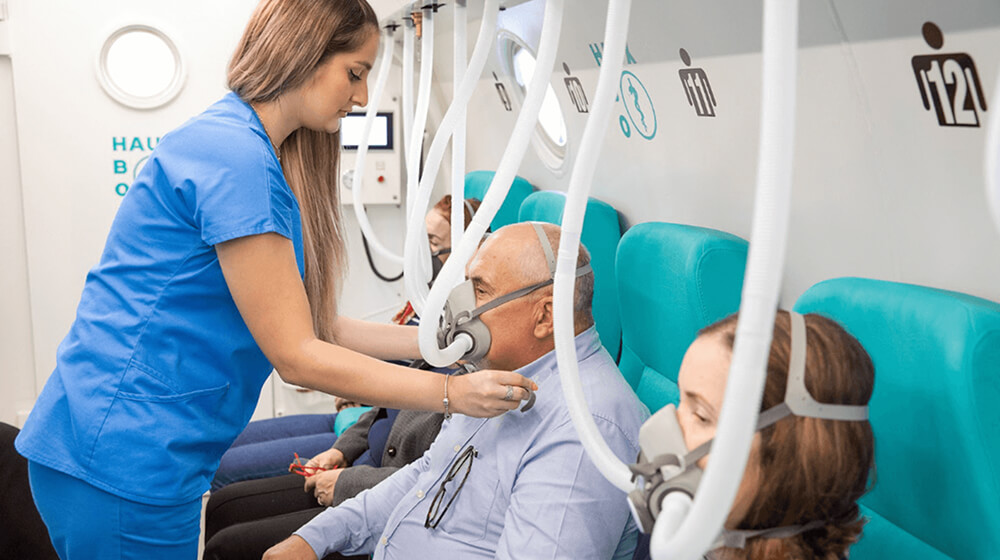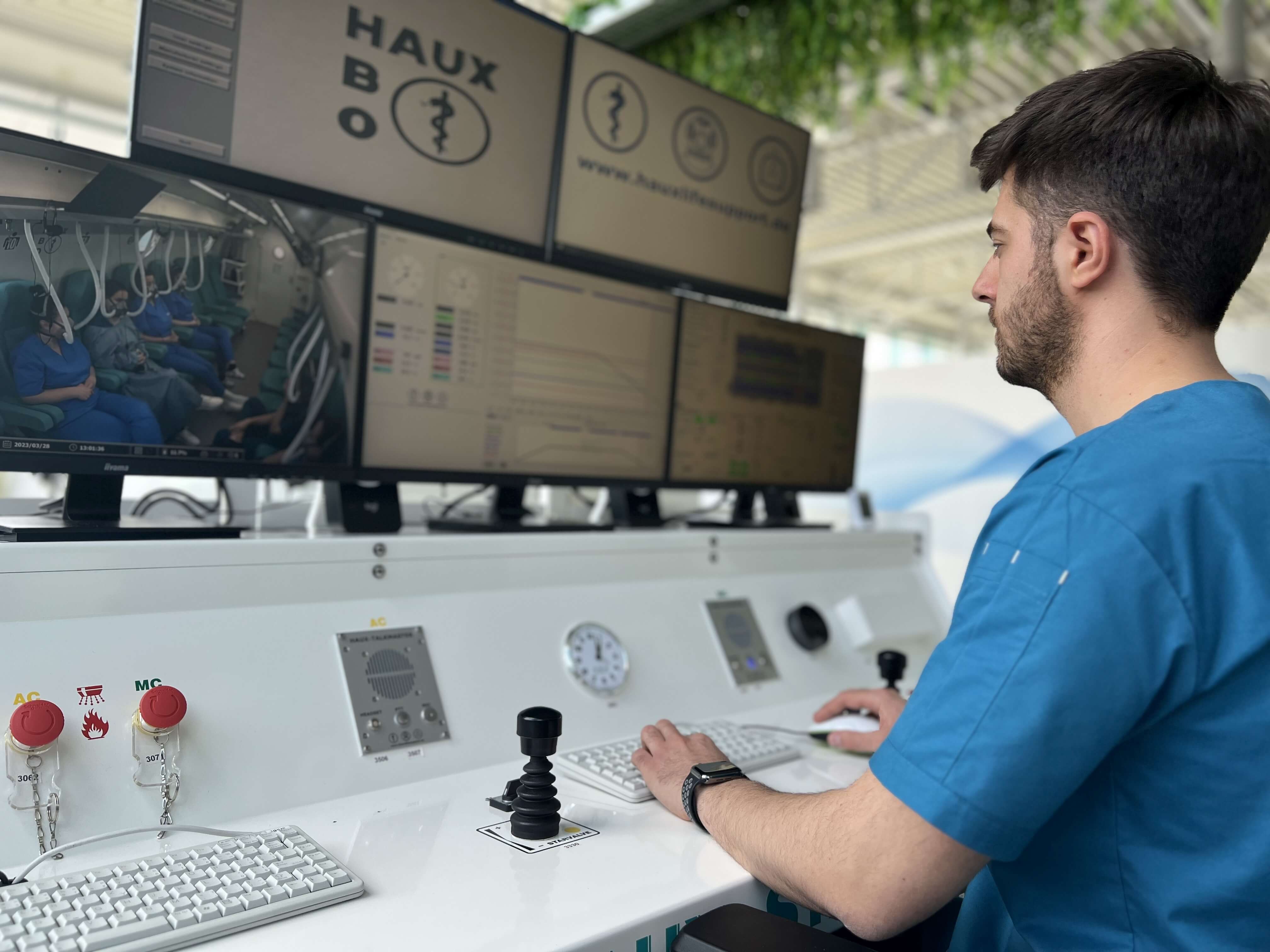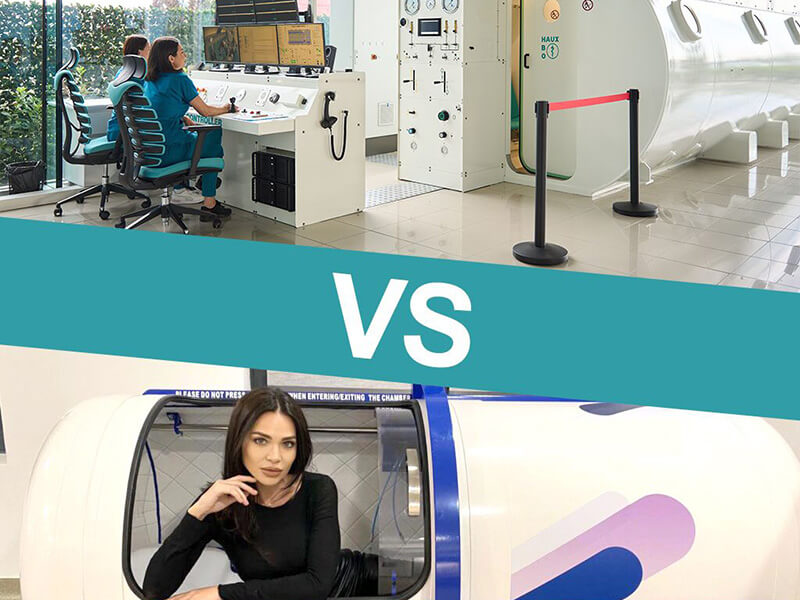
Article reviewed by: Dr. Sturz Ciprian, Dr. Tîlvescu Cătălin and Dr. Alina Vasile
Article updated on: 22-05-2025
Contraindications of Hyperbaric Oxygen Therapy | What You Need to Know Before Treatment
- Hyperbaric oxygen: what it is and what are its uses?
- Contraindications of hyperbaric oxygen therapy
- Rare side effects in hyperbaric oxygen therapy
- Conclusion
Hyperbaric oxygen therapy is one of the most fascinating modern medical discoveries, with a wide range of benefits for human health. Although it is often viewed as a safe and highly effective treatment, like any other therapy, hyperbaric therapy also has its limitations. For certain categories of patients or in certain medical conditions, this therapy can also present risks. Therefore, understanding the contraindications of hyperbaric therapy is essential for doctors, patients, and all those who want to explore the advantages of this therapeutic method.
Hyperbaric oxygen: what it is and what are its uses?
Hyperbaric oxygen therapy (HBOT) is an innovative therapeutic method, increasingly used in modern medicine to accelerate healing and support the body's natural recovery processes. It involves the patient breathing pure oxygen (100%) in a controlled environment, in a special pressurized chamber at a pressure higher than normal atmospheric pressure, usually between 1.5 and 3 absolute atmospheres (ATA).
This increased pressure allows oxygen to dissolve in much larger quantities in plasma, exceeding the limits imposed by normal transport through hemoglobin in red blood cells. Thus, oxygen reaches more easily and in larger quantities to tissues affected by inflammation, ischemia, or severe infections.
Oxygen plays an essential role in energy production (ATP) in mitochondria, through a process called oxidative phosphorylation, and the administration of oxygen under hyperbaric conditions amplifies this process, accelerating tissue healing and activating the body's antioxidant systems, as shown by studies.
According to the guidelines of the Undersea and Hyperbaric Medical Society (UHMS), hyperbaric therapy is indicated in a varied range of conditions, from carbon monoxide poisoning and arterial gas embolism, to gas gangrene or severe radiation-induced injuries, such as osteoradionecrosis or soft tissue lesions. Additionally, hyperbaric therapy is used in treating diabetic ulcers and chronic wounds, necrotizing soft tissue infections, compartment syndrome, and acute ischemia. Other indications include refractory osteomyelitis, severe acute anemia, and moderate to severe thermal burns, all benefiting from the increased oxygen supply that supports the body's natural healing processes.
The benefits of hyperbaric oxygen therapy are multiple, varied, and well documented in specialized medical literature. One of the most important advantages is the significant reduction in healing time, through improved oxygenation of affected tissues and stimulation of new blood vessel formation.
Additionally, hyperbaric oxygen plays an essential role in stimulating cellular function and accelerating tissue regeneration, helping the body replace damaged cells more quickly. Through its anti-inflammatory effects, the therapy contributes to reducing local edema and ameliorating inflammatory symptoms associated with various chronic or acute conditions.
Moreover, hyperbaric oxygen therapy improves the body's natural defense mechanisms against infections, including those caused by antibiotic-resistant bacteria, by increasing immune cell activity and the production of free radicals with antimicrobial role, as medical studies show.
The general benefits of the therapy extend to neurological recovery processes, supporting recovery after strokes or traumatic brain injuries. Through all these positive effects, hyperbaric therapy becomes a valuable therapeutic option in both acute pathologies and complex chronic conditions.

Contraindications of hyperbaric oxygen therapy
Although hyperbaric oxygen therapy brings numerous impressive health benefits, it is not suitable for everyone. As emphasized by the Undersea and Hyperbaric Medical Society guidelines, contraindications are divided into two major categories: absolute and relative. Absolute contraindications represent those situations where hyperbaric oxygen therapy is prohibited, because the risks far exceed the possible benefits. In contrast, relative contraindications indicate conditions where therapy can still be performed, but with special precautionary measures and careful monitoring.
At the Hyperbarium clinic, doctors place special importance on the detailed evaluation during the initial consultation, precisely to identify any absolute or relative contraindications and to exclude risks that could compromise patient safety. This stage is essential for personalizing treatment and ensuring a therapeutic protocol adapted to each individual case.
Absolute contraindications
There are certain situations where the administration of hyperbaric oxygen therapy is completely prohibited due to the significant risks involved. These situations are known as absolute contraindications, because the risks are much greater than any possible therapeutic benefit. The classification of contraindications into absolute and relative is widely accepted in medical practice and is detailed in internationally recognized guidelines.
Untreated pneumothorax
Untreated pneumothorax is considered an absolute contraindication for hyperbaric oxygen therapy, because exposure to increased pressure can dramatically worsen the problem. Free air present in the pleural cavity can expand dangerously, which can lead to complete lung collapse or the development of tension pneumothorax, a severe medical emergency. During a hyperbaric oxygen therapy session, the additional pressure can transform a minor injury into a major complication, endangering the patient's life. Therefore, any suspicion of pneumothorax requires radiological confirmation and prompt treatment before initiating hyperbaric therapy, according to medical studies. The specialist doctor must carefully evaluate each case, as some minor pneumothoraces, properly treated, may subsequently allow safe access to the hyperbaric chamber.
Recent treatment with doxorubicin
Patients who have recently received doxorubicin treatment must be evaluated with great care before being subjected to hyperbaric oxygen therapy, as there is an increased risk of amplifying cardiac toxicity. Doxorubicin is a chemotherapeutic agent that, in addition to its therapeutic effects, can cause significant damage to the heart muscle, and subsequent exposure to high levels of oxygen under pressure can accentuate oxidative stress on cardiac cells. Clinical studies have demonstrated that the risk of heart failure and arrhythmias increases significantly under these conditions. For this reason, patients recently treated with doxorubicin are either excluded from hyperbaric therapy, or are monitored very strictly if the benefits following hyperbaric oxygen therapy exceed the identified risks.
Recent therapy with bleomycin
Bleomycin is a chemotherapeutic agent frequently used for treating certain types of cancer, but which has the notorious adverse effect of being able to induce severe pulmonary toxicity. Administering hyperbaric oxygen therapy in such cases can considerably worsen this risk, increasing the probability of developing pulmonary fibrosis, a serious condition characterized by irreversible scarring of lung tissue. Clinical studies suggest that bleomycin-induced pulmonary fibrosis is hypersensitive to additional oxygen exposure, as this can accentuate oxidative stress and pulmonary inflammation. In this case too, patients who have been treated with this chemotherapeutic agent must be evaluated by the team at the clinic where hyperbaric oxygen therapy is performed, but in most cases, the therapy is avoided to prevent irreversible respiratory deterioration.
Relative contraindications
Not all conditions that can cause problems during hyperbaric oxygen therapy completely exclude the possibility of using this therapy. There are situations where treatment can be performed, but only with increased attention and specific adaptations. These cases are known as "relative contraindications" and require careful evaluation of risks and benefits before each hyperbaric oxygen therapy session. Among them are:
Acute upper respiratory tract infections
Acute upper respiratory tract infections, such as colds, sinusitis, or otitis, can increase the risk of barotrauma to the ears and sinuses during hyperbaric oxygen therapy. This happens because, under conditions of increased pressure, air trapped in these spaces can no longer be properly balanced, leading to severe pain, inflammation, or even tympanic perforations and sinus complications. Even trivial nasal congestion can compromise the body's ability to equalize pressure efficiently during oxygen therapy sessions. For this reason, it is recommended that patients be evaluated and, if necessary, hyperbaric treatments be postponed until acute infections are resolved.
Chronic obstructive pulmonary disease (COPD)
Patients with chronic obstructive pulmonary disease (COPD) have an increased risk of carbon dioxide (CO2) retention when exposed to therapies with oxygen in high concentrations, as is the case with hyperbaric oxygen therapy. This CO2 retention can lead to hypercapnic narcosis, a dangerous complication that affects brain function. For these patients, it is essential that HBOT treatments be performed with careful monitoring of blood gases and careful adaptation of therapeutic protocols. Rigorous prior evaluation, possibly through arterial blood gas tests, helps identify high-risk patients and appropriately adjust the treatment plan.
Claustrophobia
Patients suffering from claustrophobia may experience significant discomfort during hyperbaric oxygen therapy, given the enclosed spaces and duration of sessions. Therefore, before initiating treatment, a brief psychological evaluation and discussion of anxiety management strategies are recommended. Light sedation, administered under careful medical supervision, may be an option for more severe cases. Alternatively, progressive desensitization techniques, such as gradual exposure to the hyperbaric chamber environment, controlled breathing exercises, or relaxation training, have proven extremely effective in increasing treatment tolerance.
At the Hyperbarium clinic, patients benefit from a hyperbaric chamber that is not only modern, but also one of the largest in Europe, with a capacity of 16 seats. The generous space, ambient lighting, and the possibility of staying in the presence of other people significantly contribute to reducing the sensation of claustrophobia and creating a more comfortable and friendlier environment for patients.
Pregnancy
The use of hyperbaric oxygen therapy during pregnancy requires careful and personalized evaluation for each individual case. Although there are situations where hyperbaric therapy can be extremely beneficial, such as treating carbon monoxide poisoning, it is important that risks and benefits be weighed very carefully. Clinical studies suggest that hyperbaric oxygen cannot produce malformations, but physiological changes during pregnancy and increased sensitivity to oxidative stress can influence therapy outcomes. Therefore, the general recommendation is that hyperbaric oxygen therapy be used in pregnancy only in well-justified emergency cases, and together with careful monitoring of both mother and fetus.
Uncontrolled epileptic seizures
Patients with a history of epilepsy or predisposition to seizures must be carefully evaluated before undergoing hyperbaric therapy sessions, as the therapy can increase the risk of hyperoxic seizures. Exposure to increased oxygen levels, especially at high pressures, can affect neuronal balance and can trigger epileptiform activity in sensitive patients. According to recent studies, most hyperoxic seizures occur during prolonged exposure to pressures above 2 ATA and are usually reversible if managed promptly. Therefore, adaptation of treatment protocols and continuous monitoring of patients with neurological risk is important.
Recent ear or sinus surgery
Recent surgical interventions at the ear or sinus level represent a major challenge in the context of hyperbaric oxygen therapy, as the increased pressure applied during therapy can compromise the delicate healing process and can lead to dehiscence (opening) of incisions or surgical grafts. High pressure can exert additional forces on still fragile tissues, increasing the risk of postoperative complications such as bleeding, infections, or accentuated pain. For this reason, it is recommended that patients wait an adequate recovery period before initiating HBOT, with the decision being made in close collaboration with the attending physician and barochamber operator.
High fever
The presence of high fever at the time of hyperbaric therapy is an important risk factor, as increased body temperature amplifies the toxic effects of oxygen on the central nervous system. Higher temperature accelerates metabolic processes and sensitizes nerve cells to oxidative stress, thus increasing the risk of seizures. For this reason, patients with fever must postpone the hyperbaric oxygen therapy session until temperature normalization, to significantly reduce risks and ensure safe treatment conduct.
If you are considering undergoing this type of treatment, it is essential to discuss beforehand with a specialist doctor. At the Hyperbarium clinic, our multidisciplinary team, consisting of specialists in infectious diseases, cardiology, general surgery, diabetes, nutrition and metabolic diseases, internal medicine, neurology, orthopedics, pneumology, and medical recovery, works together with experts in hyperbaric medicine to offer rigorous evaluations and personalized recommendations. The advice of a specialist before starting hyperbaric oxygen therapy can help you identify any risks and benefit from safe and effective treatment.

Rare side effects in hyperbaric oxygen therapy
Hyperbaric oxygen therapy is an efficient and safe method in treating many conditions, but, like any form of therapy, it can also have some side effects. In rare cases, at the central nervous system (CNS) level, reactions such as dizziness, nausea, temporary visual disturbances, or, in exceptional situations, seizures caused by prolonged exposure to very high oxygen levels (hyperoxia) may occur.
It is important to emphasize that such reactions generally occur in the context of prolonged and repeated exposures, especially in special cases or intensive treatments, which are not characteristic of conditions frequently treated through hyperbaric oxygen therapy. In usual situations, the risk of these effects is very low, and through careful patient monitoring and adaptation of treatment duration and pressure, they can be easily avoided. These reactions are usually reversible and manageable within a safe medical protocol.
Additionally, in certain situations, lung sensitivity may appear, manifested by temporary reduction in gas exchange efficiency or, very rarely, by reversible pulmonary edema. This is precisely why hyperbaric oxygen treatments are carefully dosed, personalized, and medically supervised, to ensure maximum benefits with minimal risks.
For this reason, hyperbaric oxygen therapy should never be performed in an unaccredited center or one not supervised by specialized medical staff, as the lack of rigorous control can transform a valuable therapy into a potential health hazard.
Regarding ocular health, patients may develop transient myopia, a phenomenon attributed to prolonged exposure to hyperbaric oxygen. These changes are usually temporary and reversible after therapy completion, but must be mentioned to patients before treatment begins, to ensure complete and correct information.
Conclusion
Hyperbaric oxygen therapy represents a modern and valuable therapeutic tool, which can bring considerable benefits when administered correctly. Rigorous patient selection, complete pre-therapeutic evaluation, and careful monitoring are essential to maximize positive results and minimize any risks.
At the Hyperbarium clinic, our multidisciplinary team, consisting of specialists in infectious diseases, cardiology, general surgery, diabetes, nutrition and metabolic diseases, internal medicine, neurology, orthopedics, pneumology, and medical recovery, collaborates closely with experts in hyperbaric medicine to offer rigorous evaluations and personalized recommendations for each patient.
All procedures are conducted with strict adherence to international safety standards, at the highest possible level, to guarantee both treatment effectiveness and complete patient protection at every stage of therapy.
With the support of a dedicated team and through the application of the most rigorous medical protocols, hyperbaric oxygen therapy becomes a safe, efficient experience with real benefits for long-term health recovery and support.




